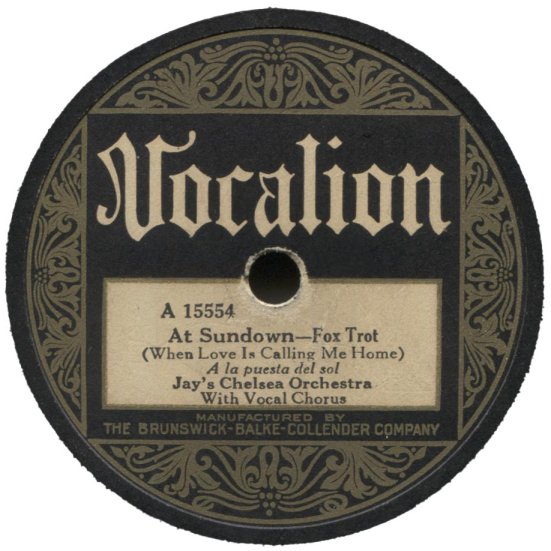
“At Sundown”
Jay’s Chelsea Orchestra; Vaughn DeLeath, vocal
(Vocalion A-15554) April 21, 1927
“My Idea of Heaven”
Jay’s Chelsea Orchestra; Vaughn DeLeath, vocal
(Vocalion B-15554) April 21, 1927
From the Edward Mitchell collection, here are two upbeat, happy recordings by the Harry Reser Orchestra, issued under the recording pseudonym of Jay’s Chelsea Orchestra.
Resers’s band made hundreds of recordings under its own name and a wide array of pseudonyms throughout the 1920s and early 1930s.
Some immediately stand out as having been made by Reser with their Tom Stacks vocals and Reser’s trademark banjo solos. Here is a link to a recent posting that features a recording with the unmistakable Reser sound.
But many recordings that his band made under a pseudonym, particularly on low-priced “dime store” labels, feature more or less standard dance band arrangements, and the only way most would know that they were by Reser’s band would be by looking the recording up in a discography.
These are good examples of such recordings. Vocalion was founded by the Aeolian Company, a major manufacturer of pianos and organs. Aeolian sold Vocalion to Brunswick in 1924, which converted it into a lower-priced subsidiary label. Sometimes, recordings by big-name groups, such as Ben Bernie And His Hotel Roosevelt Orchestra, that were issued on Brunswick were reissued on Vocalion under pseudonyms such as Al Goering’s Collegians. In other instances, such as this record, recordings were made specifically for release on Vocalion.
Other examples of more generic recordings that Reser made for Brunswick were issued under the pseudonyms of the Park Lane Orchestra and the Clevelanders. Many of these are wonderful in their own right – but one would not be able to identify them as being by Reser’s band simply by listening to them.
The Harry Reser band made another recording of “At Sundown” in the band’s trademark style for Columbia as the Clicquot Club Eskimos, named after an early network radio program the band starred in. You can hear that recording on YouTube at this link. Not only does it provide a great example of the Reser band at what I consider to be their best and a vocal by Tom Stacks, who sang on most such Reser recordings, it also demonstrates the superiority of the sound and fidelity of Columbia’s electrical recording process over Brunswick’s during this period.
I have a copy of the Clicquot Club Eskimo’s recording of “At Sundown” and was surprised to realize that I have never added it to Radio Dismuke’s playlist – an omission I plan to correct as soon as I can locate the record.
The uncredited vocal on both of these recordings is by Vaughn DeLeath, whose voice was very well-known in the 1920s through radio broadcasts, and on the over 300 sides she recorded for Edison, Columbia, Brunswick, OKeh, and Victor. She was the very first female vocalist to broadcast on an ongoing basis, starting in 1920 at Lee DeForest’s experimental station 2XG, before the first commercial radio broadcasting license was issued to KDKA in November of that year.
Some credit Vaughn DeLeath as the originator of “crooning,” the soft, intimate singing style that soon became standard for popular music vocals and made possible by the advent of the microphone, first for radio broadcasting and then for recordings. She was also the first female vocalist to perform on television through experimental broadcasts made during the late 1920s.
The “At Sundown” side of this record has some surface damage. Fortunately, most of its impact was at frequencies much higher than the music and could be removed. At frequencies closer to the music, I was able to minimize the volume of the defects, which shouldn’t be particularly noticeable on most speakers. But, on other speakers and for those who have artificially boosted the treble on their playback devices, they might be more noticeable.
